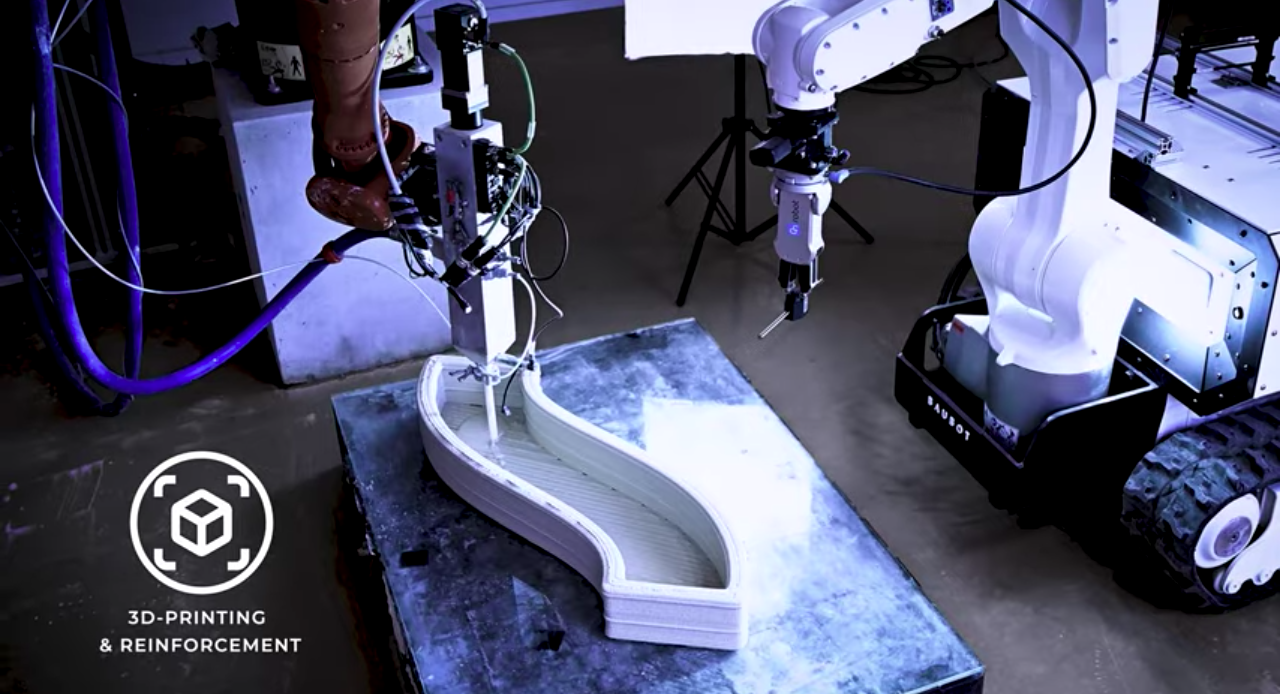Additive construction is currently in the early stages of its evolution and commercialization, with just a handful of businesses demonstrating the possibilities of this emerging technology. In most cases, they rely on a gantry-style cement printing system to produce walls and other elements made either in an environmentally controlled facility off-site or produced on-site. A new Austrian startup, Printstones, has just announced a new additive construction concept that really differentiates itself from the pack.
The company’s recently-unveiled Baubot is a mobile robotic system for the construction industry and, while it can 3D print cement for building purposes, this is just one of a variety of tasks it can perform around the job site. Running on tracks at safe speeds of up to 2 mph (3.2 km/h), the robot can either be remotely controlled by smartphone or run on pre-programmed commands. The system climbs upstairs and rolls through doorways for eight-hours of operation, wielding a robotic arm to perform milling, drilling, driving screws, welding, plasma cutting, laying bricks, sanding, painting and more.
Among these tasks is 3D printing. In 2017, the team behind Prinstones received support from Vienna incubator INITS that drove their concrete printing work. This began with the PrintStones X1 prototype, which could print an area of 1m3 and was demonstrated to produce a variety of elements, such as bricks, panels, design elements such as potters, furniture and more. The Baubot is a refined version of this initial system that can now not only print concrete on-site, but also work with a team to integrate reinforcement material or other elements in the construction process to overcome previous limitations of additive construction. The 3D printing element of this robot doesn’t seem too dissimilar to from the Minibuilders project from students at the Institute for Advanced Architecture of Catalonia (IAAC) in Spain.
So far, there are Baubots available or in development. With a vehicle payload of 500 kg, a robot payload of 10 kg and a reach of 1,000 mm, the MRS10-100 is a universal bot for precision operations in compact spaces. The MRS 70-210 is meant for larger, more heavy-duty tasks, with a vehicle payload of 900 kg, a robot payload of 70 kg, and a reach of 2100 mm. The company has also conceived of a shipping container-based production cell for additive and subtractive manufacturing, called the SRS100-400. This gantry-style system has a payload of 100 kg and a production area of 4.2 m2.
The company ultimately aims to allow software developers to use Printstones’ SDK to create applications for the robots’ ecosystem, with hardware tools and apps distributed through its platform. The company says that the cost of each unit depends on the exact application of the robots, but the starting price is set around €150,000 with lead time estimated around six months for each unit.
For a variety of reasons, the construction industry is far behind general manufacturing in terms of efficiency and reliability. The primary cause is the fact that buildings are more or less one-off products and, therefore, can’t be made in a highly controlled assembly line environment. However, there are a number of developments taking place that are changing this fact and 3D printing may play an important role.
Additive construction with concrete and other materials may introduce greater reliability and repeatability to the production of building elements, which combines robotics with the larger trend of modular construction and prefab. This trend involves the large batch manufacturing of elements off-site for shipment to the building location, allowing for production that more closely-resembles mass manufacturing.
With Printstones, we see robotics as increasingly relevant construction. Other firms, such as Doxel, are envisioning the use of similar tracked robots for providing real-time updates on construction, analyzing safety issues, and other applications dependent on machine vision and artificial intelligence. Drones are being deployed for general surveilling and regular site updates, as well.
Given the issues that 3D printing has with quality control at this stage in the technology’s development, one wonders just how much more difficult that is for additive construction and robotics. How difficult is it to program a robot to perform CNC work on a jobsite compared to manual labor? Is robotics advanced enough and easy enough to use at this stage that bringing a gang of Baubots onto a job will be feasible? Moreover, is the construction ready to begin operating robots or will that take more training that will see adoption grow only later on down the line?
My gut instinct tells me that we’re just not there yet, but if we don’t have minds like those behind Prinstones working on it, then it would probably never happen.
Subscribe to Our Email Newsletter
Stay up-to-date on all the latest news from the 3D printing industry and receive information and offers from third party vendors.
Print Services
Upload your 3D Models and get them printed quickly and efficiently.
You May Also Like
3D Printing News Briefs, June 28, 2025: Defense Accelerator, Surgical Models, & More
In this weekend’s 3D Printing News Briefs, 3YOURMIND was selected to join an EU Defense Accelerator, and PTC has announced model-based definition (MBD) capabilities within Onshape. Finally, a study out...
3D Printing News Briefs, June 7, 2025: Digital Inventory, Thermal Management Solutions, & More
In this weekend’s 3D Printing News Briefs, UK-based 3D printing bureau 3D People responds to global instability, and AEWIN chose Fabric8Labs’ technology for advanced thermal management solutions. We’ll end with...
Low-Cost Binocular Indirect Ophthalmoscope Made with CAD Software & Bambu Lab X1C
3D printing is increasingly used in the fabrication of diagnostic equipment, including ophthalmology, which is a medical specialty that deals with the diagnosis and treatment of eye conditions and diseases....
3D Printing News Briefs, May 17, 2025: Color-Changing Materials, Humanoid Robot, & More
We’re covering research innovations in today’s 3D Printing News Briefs! First, Penn Engineering developed 3D printed materials that change color under stress, and UC Berkeley researchers created an open source,...



































